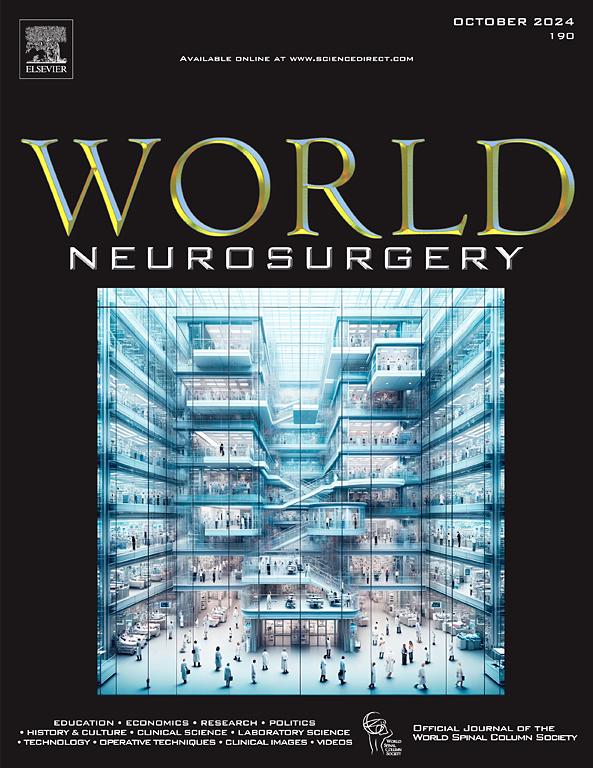神经外科开颅术中“皮质危险静脉”的识别与保护策略。
IF 1.9
4区 医学
Q3 CLINICAL NEUROLOGY
引用次数: 0
摘要
目的:探讨神经外科开颅术中皮质危险静脉的识别及处理技巧和策略。方法:回顾性分析2022年7月至2024年6月期间37例颅脑开颅术中皮质危险静脉保护的患者。术前,采用高分辨率MRI数据进行三维可视化,划定切除边缘,规划相关皮质危险静脉的处理,包括桥静脉、浅表Sylvian静脉、吻合静脉和流利皮层静脉。术中注意保留皮层危静脉。术后,根据症状、影像学表现、体格检查和其他临床表现评估静脉流动障碍。结果:37例患者术前脑结构及静脉三维可视化与术中观察相符。术中切除并保护皮层危静脉47条,其中桥静脉14条,浅表静脉5条,吻合静脉8条,累及中央叶静脉20条。6例患者术中出现静脉损伤,采用缝合或加压止血处理。没有患者表现出明确的术后症状或可归因于静脉梗死的影像学改变。结论:本研究强调了将皮质危险静脉保护纳入手术计划和病变切除的重要性。采用三维可视化技术来识别皮质危险静脉,并在切除过程中保持静脉的完整性,可以减轻术后静脉梗死相关的缺陷,而不会对治疗效果产生不利影响。本文章由计算机程序翻译,如有差异,请以英文原文为准。

Identification and Protective Strategies for “Cortical Dangerous Veins” in Neurosurgical Craniotomies
Objective
To investigate the identification and management techniques and strategies for cortical dangerous veins during neurosurgical craniotomies.
Methods
We retrospectively analyzed 37 patients who underwent craniotomies involving the intraoperative protection of cortical dangerous veins between July 2022 and June 2024. Preoperatively, high-resolution magnetic resonance imaging data were used for three-dimensional visualization to delineate the resection margins and plan the management of related cortical dangerous veins, including bridging veins, superficial Sylvian veins, anastomotic veins, and veins in the eloquent cortex. Intraoperatively, attention was paid to preserving the cortical dangerous veins. Postoperatively, venous flow disturbances were assessed on the basis of symptoms, imaging findings, physical examinations, and other clinical findings.
Results
Preoperative three-dimensional visualization of the cerebral structures and veins corresponded to the intraoperative observations in all 37 patients. Forty-seven cortical dangerous veins were dissected and protected intraoperatively, including 14 bridging veins, five superficial Sylvian veins, eight anastomotic veins, and 20 veins involving the central lobe. Six patients experienced intraoperative venous injury, which was managed by suturing or pressure hemostasis. No patient exhibited definite postoperative symptoms or radiological changes attributable to venous infarction.
Conclusions
This study highlights the importance of integrating cortical dangerous vein protection into surgical planning and lesion resection. Employing three-dimensional visualization to advance identification of cortical dangerous veins and preserve vein integrity during resection may mitigate postoperative venous infarction–related deficits without adversely affecting the treatment efficacy.
求助全文
通过发布文献求助,成功后即可免费获取论文全文。
去求助
来源期刊

World neurosurgery
CLINICAL NEUROLOGY-SURGERY
CiteScore
3.90
自引率
15.00%
发文量
1765
审稿时长
47 days
期刊介绍:
World Neurosurgery has an open access mirror journal World Neurosurgery: X, sharing the same aims and scope, editorial team, submission system and rigorous peer review.
The journal''s mission is to:
-To provide a first-class international forum and a 2-way conduit for dialogue that is relevant to neurosurgeons and providers who care for neurosurgery patients. The categories of the exchanged information include clinical and basic science, as well as global information that provide social, political, educational, economic, cultural or societal insights and knowledge that are of significance and relevance to worldwide neurosurgery patient care.
-To act as a primary intellectual catalyst for the stimulation of creativity, the creation of new knowledge, and the enhancement of quality neurosurgical care worldwide.
-To provide a forum for communication that enriches the lives of all neurosurgeons and their colleagues; and, in so doing, enriches the lives of their patients.
Topics to be addressed in World Neurosurgery include: EDUCATION, ECONOMICS, RESEARCH, POLITICS, HISTORY, CULTURE, CLINICAL SCIENCE, LABORATORY SCIENCE, TECHNOLOGY, OPERATIVE TECHNIQUES, CLINICAL IMAGES, VIDEOS
 求助内容:
求助内容: 应助结果提醒方式:
应助结果提醒方式:


